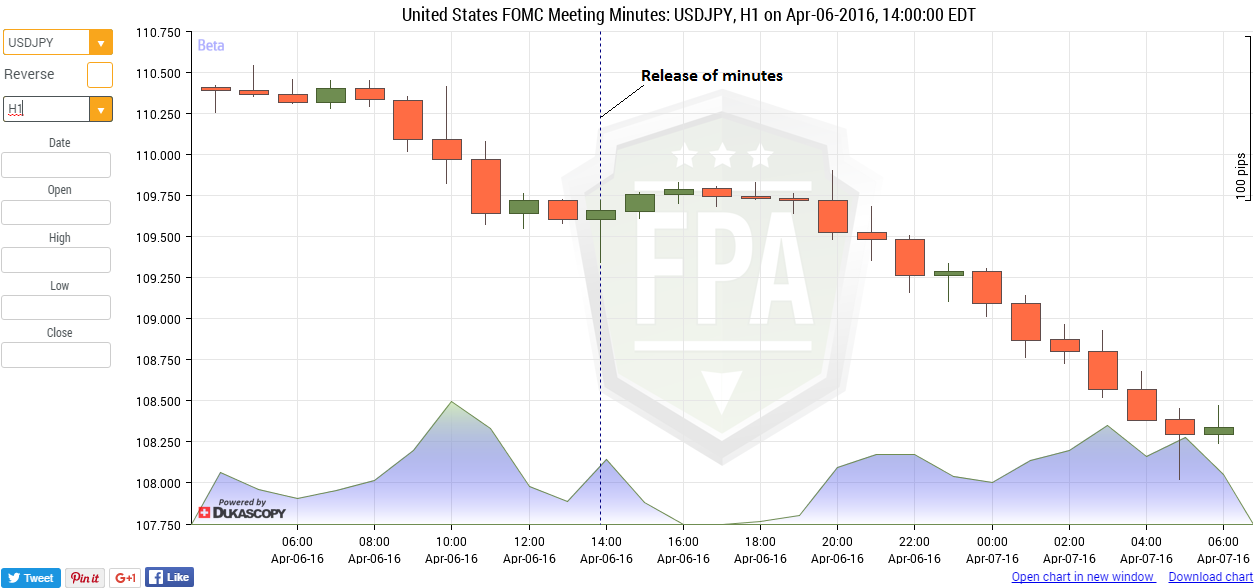The US Dollar Under Pressure: Could the Fed’s Minutes be Responsible in More Ways than One?

The repeated attribution of risk to international factors within the Fed’s latest assessment may be sparking a search for safety with the yen being the number one destination.
- Bank of Japan intervention now likely as corporates not prepared for stronger currency
If there was a prize for volatility, the USD/JPY would be walking up to the podium right now and shaking the hand of a dignitary.
The pair plunged almost 200 points on Thursday April 7, from an open price of 109.78 to a low of 107.90.
That’s not all - this is the fifth down-day in a row, taking the exchange rate from the 112s to the 108s.
The weakening dollar is seen as the main cause for the present sell-off after a combination of Janet Yellen’s cautious speech and the uninspiring March FOMC minutes led investors to expect a longer delay before the Fed raises interest rates.
Given the dollar strengthens when the Fed raises interest rates a further delay was bound to cause it to weaken.
Safe-haven Flows into the Yen
USD/JPY’s superlative decline cannot be completely attributed to dollar weakness,however, as a quick comparison with EUR/USD and GBP/USD reveal no-where near commensurate falls.
Therefore, much of the downside must be due to the yen which must be appreciating at the same time as the dollar is falling.
Being a safe-haven the yen tends to attract demand when things are going ‘pete-tong’ (rhyming slang for “wrong”), however, search all you like, this does not appear to be the case today.
There have been no reports of a major banking crisis, no earthquakes, no terrorist bombings; the authorities in China have not devalued the yuan again, China data has actually been a little better-than-expected of late; and finally, the Bank of Japan have not been talking about rolling out their printing presses again - in their almost Captain Ahab obsessive hunt to destroy perennial deflation.
We are left with the possibility, that the thing which caused it, might be the gloomy assessment of the global economy contained in the minutes of the last meeting of the US Federal Reserve, published on Wednesday April 6.
It is clear from browsing the document that once again, the erstwhile members of the Fed mesrs - Yellen, Fischer, Dudley, Brainard, Mester and Co - argued for caution in raising interest rates due to the worsening outlook for the world economy.
“Several participants also argued for proceeding cautiously in reducing policy accommodation because they saw the risks to the U.S. economy stemming from developments abroad as tilted to the downside.”
It was not the only mention they made of risks originating from abroad:
“Furthermore, participants generally saw global economic and financial developments as continuing to pose risks to the outlook for economic activity and the labor market in the United States.”
The yuan sell-off of January has not been fully digested:
“In particular, several participants expressed the view that the underlying factors abroad that led to a sharp, though temporary, deterioration in global financial conditions earlier this year had not been fully resolved and thus posed ongoing downside risks.”
Foreign factors made their appearance in almost every paragraph of the minutes:
“Most participants, while recognizing the likely positive effects of recent policy actions abroad, saw foreign economic growth as likely to run at a somewhat slower pace than previously expected, a development that probably would further restrain growth in U.S. exports and tend to damp overall aggregate demand.”
In their commentary, analysts also remarked on the preponderance of factors emanating from the beyond the borders of the USA:
“Apparently many policymakers are worried about low inflation and growth outside of the U.S. and the implications that it could have on the domestic economy," noted analyst Kathy Lien of BK Asset Management.
Is it possible the Fed’s minutes started the sell-off?
It’s an interesting though difficult-to-prove theory that the economic ‘xenophobia’ contained in the Fed’s minutes kicked off the almost 200-point decline in the yen.
Looking at the USD/JPY chart at the time of the publication of the minutes it appears that if there was a link it was not made immediately. Indeed, if anything the yen weakened in the immediate aftermath of publication.
However, it is also possible markets had a delayed reaction whilst digesting the news.
BOJ Intervention Now Likely
Looking ahead and the steep appreciation of the yen could very well prompt a response from the BOJ.
This might well take the form of direct intervention, as it did on previous occasions.
“With the dollar near the Yen 110 mark, investors may need to keep an eye on potential verbal intervention from the BOJ,” writes the Wall Street Journal.
This is due to the fact that most Japanese companies are only financially prepared for the yen reaching 115, and any lower and they start to lose money:
“Most Japanese corporations are hedged at 115, so they are bleeding profits at 110 and lower,” says Kathy Lien, managing director of FX Strategy for BK Asset Management, adding:
“To get the most bang for their yens, the BoJ always likes to intervene when speculators are long.”
Given yen positions are at their highest levels since 2008, Lien points out it makes the currency “prime for intervention.”






